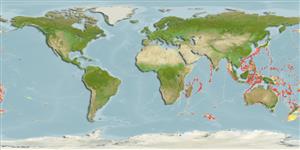Teleostei (teleosts) >
Anguilliformes (Eels and morays) >
Congridae (Conger and garden eels) > Congrinae
Etymology: Congriscus: Derived from Latin, conger = conger (Ref. 45335).
More on author: Norman.
Environment: milieu / climate zone / depth range / distribution range
Ecology
Marine; bathydemersal; depth range 354 - 820 m (Ref. 54804). Subtropical
Indo-West Pacific: Maldives, Madagascar, Australia, near the Philippines, New Caledonia, Vanuatu, Fiji, Wallis and Futuna.
Size / Weight / Age
Maturity: Lm ? range ? - ? cm
Max length : 35.2 cm SL male/unsexed; (Ref. 26165)
Life cycle and mating behavior
Maturity | Reproduction | Spawning | Eggs | Fecundity | Larvae
Adam, M.S., N.R. Merrett and R.C. Anderson, 1998. Additions to the fish fauna of the Maldive Islands. Part 1: An annotated checklist of the deep demersal fishes of the Maldive Islands. Ichthyol. Bull. J. L. B. Smith Inst. Ichthyol., May, No. 67:1-19. (Ref. 30828)
IUCN Red List Status (Ref. 130435)
Threat to humans
Harmless
Human uses
More information
Common namesSynonymsMetabolismPredatorsEcotoxicologyReproductionMaturitySpawningSpawning aggregationFecundityEggsEgg development
Age/Size
Growth
Length-weight
Length-length
Length-frequencies
Morphometrics
Morphology
Larvae
Larval dynamics
Recruitment
Abundance
BRUVS
ReferencesAquacultureAquaculture profileStrainsGeneticsElectrophoresesHeritabilityDiseasesProcessingNutrientsMass conversion
Tools
Special reports
Download XML
Internet sources
Estimates based on models
Preferred temperature (Ref.
123201): 2.2 - 12.5, mean 8.6 °C (based on 273 cells).
Phylogenetic diversity index (Ref.
82804): PD
50 = 0.6250 [Uniqueness, from 0.5 = low to 2.0 = high].
Bayesian length-weight: a=0.00062 (0.00028 - 0.00136), b=3.19 (3.00 - 3.38), in cm total length, based on LWR estimates for this (Sub)family-body shape (Ref.
93245).
Trophic level (Ref.
69278): 3.8 ±0.5 se; based on size and trophs of closest relatives
Resilience (Ref.
120179): Medium, minimum population doubling time 1.4 - 4.4 years (Preliminary K or Fecundity.).
Fishing Vulnerability (Ref.
59153): Low to moderate vulnerability (33 of 100).
